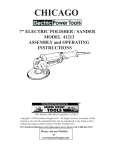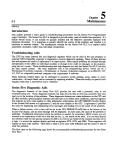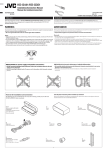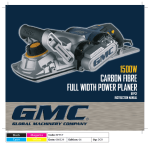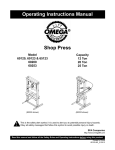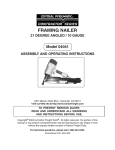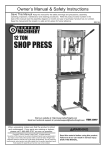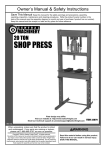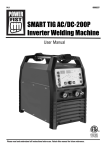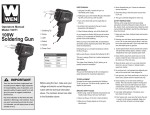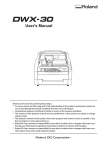Download Chicago Electric 41213 User's Manual
Transcript
7” Electric Polisher / Sander Model 41213 SET UP And Operating Instructions Diagrams within this manual may not be drawn proportionally. Due to continuing improvements, actual product may differ slightly from the product described herein. Distributed exclusively by Harbor Freight Tools®. 3491 Mission Oaks Blvd., Camarillo, CA 93011 Visit our website at: http://www.harborfreight.com Read this material before using this product. Failure to do so can result in serious injury. Save this manual. Copyright© 2007 by Harbor Freight Tools®. All rights reserved. No portion of this manual or any artwork contained herein may be reproduced in any shape or form without the express written consent of Harbor Freight Tools. For technical questions or replacement parts, please call 1-800-444-3353. Save This Manual Keep this manual for the safety warnings and precautions, assembly, operating, inspection, maintenance and cleaning procedures. Write the product’s serial number in the back of the manual near the assembly diagram (or month and year of purchase if product has no number). Keep this manual and the receipt in a safe and dry place for future reference. Important SAFETY Information In this manual, on the labeling, and all other information provided with this product: This is the safety alert symbol. It is used to alert you to potential personal injury hazards. Obey all safety messages that follow this symbol to avoid possible injury or death. Danger DANGER indicates a hazardous situation which, if not avoided, will result in death or serious injury. WARNING WARNING indicates a hazardous situation which, if not avoided, could result in death or serious injury. Caution CAUTION, used with the safety alert symbol, indicates a hazardous situation which, if not avoided, could result in minor or moderate injury. Notice NOTICE is used to address practices not related to personal injury. Caution SKU 41213 CAUTION, without the safety alert symbol, is used to address practices not related to personal injury. For technical questions, please call 1-800-444-3353. Page General Safety Rules WARNING! Read all instructions Failure to follow all instructions listed below may result in electric shock, fire, and/or serious injury. The term “power tool” in all of the warnings listed below refers to your line-operated (corded) power tool or battery-operated (cordless) power tool. SAVE THESE INSTRUCTIONS 1. Work area safety a. Keep work area clean and well lit. Cluttered or dark areas invite accidents. b. Do not operate power tools in explosive atmospheres, such as in the presence of flammable liquids, gases or dust. Power tools create sparks which may ignite the dust or fumes. c. Keep children and bystanders away while operating a power tool. Distractions can cause you to lose control. 2. Electrical safety a. Power tool plugs must match the outlet. Never modify the plug in any way. Do not use any adapter plugs with grounded power tools. Unmodified plugs and matching outlets will reduce risk of electric shock. b. Avoid body contact with grounded surfaces such as pipes, radiators, ranges and refrigerators. There is an increased risk of electric shock if your body is grounded. c. Do not expose power tools to rain or wet conditions. Water entering a power tool will increase the risk of electric shock. d. Do not abuse the cord. Never use the cord for carrying, pulling or unplugging the power tool. Keep cord away from heat, oil, sharp edges or moving parts. Damaged or entangled cords increase the risk of electric shock. e. When operating a power tool outdoors, use an extension cord suitable for outdoor use. Use of a cord suitable for outdoor use reduces the risk of electric shock. 3. Personal safety a. Stay alert, watch what you are doing and use common sense when operating a power tool. Do not use a power tool while you are tired or under the influence of drugs, alcohol or medication. A moment of inattention while operating power tools may result in serious personal injury. b. Use safety equipment. Always wear eye protection. Safety equipment such as dust mask, non-skid safety shoes, hard hat, or hearing protection used for appropriate conditions will reduce personal injuries. SKU 41213 For technical questions, please call 1-800-444-3353. Page c. Avoid accidental starting. Ensure the switch is in the off-position before plugging in. Carrying power tools with your finger on the switch or plugging in power tools that have the switch on invites accidents. d. Remove any adjusting key or wrench before turning the power tool on. A wrench or a key left attached to a rotating part of the power tool may result in personal injury. e. Do not overreach. Keep proper footing and balance at all times. This enables better control of the power tool in unexpected situations. f. Dress properly. Do not wear loose clothing or jewelry. Keep your hair, clothing and gloves away from moving parts. Loose clothes, jewelry or long hair can be caught in moving parts. g. If devices are provided for the connection of dust extraction and collection facilities, ensure these are connected and properly used. Use of these devices can reduce dust-related hazards. 4. Power tool use and care a. Do not force the power tool. Use the correct power tool for your application. The correct power tool will do the job better and safer at the rate for which it was designed. b. Do not use the power tool if the switch does not turn it on and off. Any power tool that cannot be controlled with the switch is dangerous and must be repaired. c. Disconnect the plug from the power source of the power tool before making any adjustments, changing accessories, or storing power tools. Such preventive safety measures reduce the risk of starting the power tool accidentally. d. Store idle power tools out of the reach of children and do not allow persons unfamiliar with the power tool or these instructions to operate the power tool. Power tools are dangerous in the hands of untrained users. e. Maintain power tools. Check for misalignment or binding of moving parts, breakage of parts and any other condition that may affect the power tool’s operation. If damaged, have the power tool repaired before use. Many accidents are caused by poorly maintained power tools. f. Use the power tool, accessories and tool bits etc., in accordance with these instructions and in the manner intended for the particular type of power tool, taking into account the working conditions and the work to be performed. Use of the power tool for operations different from those intended could result in a hazardous situation. SKU 41213 For technical questions, please call 1-800-444-3353. Page . Service a. Have your power tool serviced by a qualified repair person using only identical replacement parts. This will ensure that the safety of the power tool is maintained. Vibration Hazard This tool vibrates during use. Repeated or long-term exposure to vibration may cause temporary or permanent physical injury, particularly to the hands, arms and shoulders. To reduce the risk of vibration-related injury: 1. Anyone using vibrating tools regularly or for an extended period should first be examined by a doctor and then have regular medical check-ups to ensure medical problems are not being caused or worsened from use. Pregnant women or people who have impaired blood circulation to the hand, past hand injuries, nervous system disorders, diabetes, or Raynaud’s Disease should not use this tool. If you feel any medical or physical symptoms related to vibration (such as tingling, numbness, and white or blue fingers), seek medical advice as soon as possible. 2. Do not smoke during use. Nicotine reduces the blood supply to the hands and fingers, increasing the risk of vibration-related injury. 3. Wear suitable gloves to reduce the vibration effects on the user. 4. Use tools with the lowest vibration when there is a choice between different processes. . Include vibration-free periods each day of work. . Grip tool as lightly as possible (while still keeping safe control of it). Let the tool do the work. 7. To reduce vibration, maintain the tool as explained in this manual. If any abnormal vibration occurs, stop use immediately. Specific Safety Rules 1. Maintain labels and nameplates on the tool. These carry important safety information. If unreadable or missing, contact Harbor Freight Tools for a replacement. 2. Avoid unintentional starting. Prepare to begin work before turning on the tool. 3. Do not lay the polisher down until it has come to a complete stop. Moving parts can grab the surface and pull the tool out of your control. SKU 41213 For technical questions, please call 1-800-444-3353. Page 4. Do not force the Polisher/Sander. This tool will do the work better and safer at the speed and capacity for which it was designed. Do not force the pads into the vehicle being waxed/polished. Apply moderate pressure, allowing the Bonnet to rotate freely without being forced. . When waxing/polishing a vehicle, do not operate the vehicle’s engine in an enclosed area. Carbon monoxide is a colorless, odorless, vapor emitted from a vehicle’s running engine that may cause severe injury or death if inhaled. . Never lay the Polisher/Sander down until the Polishing Pad (2) has come to a full stop. The Backing Pad can grab the surface and pull the tool out of your control. 7. Make sure the vehicle being waxed/polished is free from burrs and any other foreign matter which could damage the tool. . Always unplug the Polisher/ Sander from its electrical outlet before performing any inspection, maintenance, or cleaning procedures. 9. When sanding, only use 7” sanding pads with a hook and loop back that attaches securely to the Backing Pad. 10. Connect to a GFCI. Always connect the Line Cord to a Ground Fault Circuit Interrupter (GFCI) protected electrical outlet. 11. Accessories must be rated for at least the speed recommended on the tool warning label. Wheels and other accessories running over rated speed can fly apart and cause injury. 12. Hold tool by insulated gripping surfaces when performing an operation where the cutting tool may contact hidden wiring or its own cord. Contact with a “live” wire will make exposed metal parts of the tool “live” and shock the operator. 13. Never use accessories rated for less than 3500 RPM. 14. WARNING! Avoid serious injury. Never install carbide tipped or steel circular saw blade for use on this Sander/Polisher. Never install a wood carving blade, carving disc with saw chain cutters, or a cutting carving disc on this Sander/Polisher. Never install abrasive cutoff discs and wheels, flap wheels, wire brushes, or wire (1)wheel brushes. 1. Dress properly. Do not wear loose clothing or jewelry. Contain long hair. Keep your hair, clothing, and gloves away from moving parts. Loose clothes, jewelry, or long hair can be caught in moving parts. SKU 41213 For technical questions, please call 1-800-444-3353. Page 1. When using the polisher, maintain a firm grip on the tool with both hands to resist starting torque. 17. Use clamps (not included) or other practical ways to secure and support the workpiece to a stable platform. Holding the work by hand or against your body is unstable and may lead to loss of control. 1. This product is not a toy. Keep it out of reach of children. 19. People with pacemakers should consult their physician(s) before use. Electromagnetic fields in close proximity to heart pacemaker could cause pacemaker interference or pacemaker failure. In addition, people with pacemakers should: • Avoid operating alone. • Do not use with power switch locked on. • Properly maintain and inspect to avoid electrical shock. 20. Some dust created by power sanding, sawing, grinding, drilling, and other construction activities, contains chemicals known [to the State of California] to cause cancer, birth defects or other reproductive harm. Some examples of these chemicals are: • Lead from lead-based paints • Crystalline silica from bricks and cement or other masonry products • Arsenic and chromium from chemically treated lumber Your risk from these exposures varies, depending on how often you do this type of work. To reduce your exposure to these chemicals: work in a well ventilated area, and work with approved safety equipment, such as those dust masks that are specially designed to filter out microscopic particles. (California Health & Safety Code § 25249.5, et seq.) 21. The warnings, precautions, and instructions discussed in this instruction manual cannot cover all possible conditions and situations that may occur. It must be understood by the operator that common sense and caution are factors which cannot be built into this product, but must be supplied by the operator. Save these instructions. SKU 41213 For technical questions, please call 1-800-444-3353. Page Grounding WARNING Improperly connecting the grounding wire can result in electric shock. Check with a qualified electrician if you are in doubt as to whether the outlet is properly grounded. Do not modify the power cord plug provided with the tool. Never remove the grounding prong from the plug. Do not use the tool if the power cord or plug is damaged. If damaged, have it repaired by a service facility before use. If the plug will not fit the outlet, have a proper outlet installed by a qualified electrician. Grounded Tools: Tools with Three Prong Plugs 1. Tools marked with “Grounding Required” have a three wire cord and three prong grounding plug. The plug must be connected to a properly grounded outlet. If the tool should electrically malfunction or break down, grounding provides a low resistance path to carry electricity away from the user, reducing the risk of electric shock. (See 3-Prong Plug and Outlet.) 2. The grounding prong in the plug is connected through the green wire inside the cord to the grounding system in the tool. The green wire in the cord must be the only wire connected to the tool’s grounding system and must never be attached to an electrically “live” terminal. (See 3-Prong Plug and Outlet.) 3. The tool must be plugged into an appropriate outlet, properly installed and grounded in accordance with all codes and ordinances. The plug and outlet should look like those in the following illustration. (See 3-Prong Plug and Outlet.) 3-Prong Plug and Outlet Outlets for 2-Prong Plug Double Insulated Tools: Tools with Two Prong Plugs 1. Tools marked “Double Insulated” do not require grounding. They have a special double insulation system which satisfies OSHA requirements and complies with the applicable standards of Underwriters Laboratories, Inc., the Canadian Stan- SKU 41213 For technical questions, please call 1-800-444-3353. Page dard Association, and the National Electrical Code. (See Outlets for 2-Prong Plug.) 2. Double insulated tools may be used in either of the 120 volt outlets shown in the preceding illustration. (See Outlets for 2-Prong Plug.) Extension Cords 1. Grounded tools require a three wire extension cord. Double Insulated tools can use either a two or three wire extension cord. 2. As the distance from the supply outlet increases, you must use a heavier gauge extension cord. Using extension cords with inadequately sized wire causes a serious drop in voltage, resulting in loss of power and possible tool damage. (See Table A.) 3. The smaller the gauge number of the wire, the greater the capacity of the cord. For example, a 14 gauge cord can carry a higher current than a 16 gauge cord. (See Table A.) 4. When using more than one extension cord to make up the total length, make sure each cord contains at least the minimum wire size required. (See Table A.) . If you are using one extension cord for more than one tool, add the nameplate amperes and use the sum to determine the required minimum cord size. (See Table A.) . If you are using an extension cord outdoors, make sure it is marked with the suffix “W-A” (“W” in Canada) to indicate it is acceptable for outdoor use. 7. Make sure the extension cord is properly wired and in good electrical condition. Always replace a damaged extension cord or have it repaired by a qualified electrician before using it. . Protect the extension cords from sharp objects, excessive heat, and damp or wet areas. SKU 41213 For technical questions, please call 1-800-444-3353. Page RECOMMENDED MINIMUM WIRE GAUGE FOR EXTENSION CORDS* (120/240 VOLT) NAMEPLATE AMPERES EXTENSION CORD LENGTH (at full load) 25 Feet 50 Feet 75 Feet 100 Feet 150 Feet 0 – 2.0 18 18 18 18 16 2.1 – 3.4 18 18 18 16 14 3.5 – 5.0 18 18 16 14 12 5.1 – 7.0 18 16 14 12 12 7.1 – 12.0 18 14 12 10 - 12.1 – 16.0 14 12 10 - - 16.1 – 20.0 12 10 - - - TABLE A * Based on limiting the line voltage drop to five volts at 150% of the rated amperes. Symbology Double Insulated Canadian Standards Association Underwriters Laboratories, Inc. SKU 41213 V~ A Volts Alternating Current Amperes No Load Revolutions per Minute n0 xxxx/min. (RPM) For technical questions, please call 1-800-444-3353. Page 10 Specifications Electrical Requirements Motor No Load Speed Arbor Diameter Spindle Thread 110 V~ / 60 Hz / 6 A (load) 2 Speed (2800/ 3300) 7/8” 5/8” - 11 Unpacking When unpacking, check to make sure that the item is intact and undamaged. If any parts are missing or broken, please call Harbor Freight Tools at the number shown on the cover of this manual as soon as possible. List of contents Part(s) 48 46 34 47 Description Polishing Bonnet Backing Pad Side Handle Flange Nut Q’ty 2 1 1 1 Set Up Instructions Read the entire Important Safety Information section at the beginning of this manual including all text under subheadings therein before set up or use of this product. WARNING Risk of accidental starting; resulting in serious personal injury. Turn the Power Switch of the tool to its “OFF” position and unplug the tool from its electrical outlet before assembling or making any adjustments to the tool. Note: For additional information regarding the parts listed in the following pages, refer to the Assembly Diagram near the end of this manual. Assembly 1. 2. Attach the Side Handle (34) to the Housing (16). Hold the Polisher upside down resting in your hand with your finger on the Stop Pin (3). Depress the Stop Pin (3) so that the Output Shaft (42) won’t turn. Insert the knobs protruding from the Wrench (49) into the recessed holes on the Flange Nut (47). Loosen and remove the Flange Nut (47) by turning it counterclockwise. Set the Backing Pad (46) on the Output Shaft (42). Replace the Flange Nut (47) by turning it clockwise. SKU 41213 For technical questions, please call 1-800-444-3353. Page 11 3. Depress the Stop Pin (3). Using the Wrench (49), Tighten the Flange Nut (47) by turning it clockwise until firmly in place. See Figure 1 below. 4. Wrap a clean Polishing Bonnet (48) on top of the Backing Pad (46). Tie it securely using the drawstring. Make sure to tuck any excess string inside the Bonnet. See Figure 2 below. 5. For sanding, place a sanding disk with a hole in the center onto the Backing Pad and secure it with the Flange Nut (47). See Figure 1 below. Figure 1 Flange Nut (47) Backing Pad (46 ) Output Shaft (42) Stop Pin (3) Side Handle (34) Housing (16) Figure 2 SKU 41213 Polishing Bonnet (48) For technical questions, please call 1-800-444-3353. Page 12 Operating Instructions Controls ON/OFF Switch (24) Polishing 1. Place a clean Polishing Bonnet (48) securely onto the Backing Pad (46). Tie it securely using the drawstring. Make sure to tuck any excess string inside the Bonnet Note: Prior to waxing or polishing a vehicle, make sure it’s surface has been thoroughly washed, and is free of dust, dirt, oil, grease, etc. 2. Apply about two tablespoons of wax (not included) evenly on the Polishing Bonnet (48). Do not apply the wax directly to the surface of the vehicle. The amount of wax needed will vary according to the size of the vehicle being waxed. IMPORTANT Carefully inspect the condition of the accessory before use and check the accessory WARNING continually duringinspect use. If any noted, immediately replace the accessory Carefully the damage conditionis of the stop accessory beforeand use and check the with anaccessory undamaged one. Harbor Freight Tools cannot be held responsible for damage continually during use. If any damage is noted, stop immediately causedand by replace using athe damaged accessory this tool.one. Harbor Freight Tools accessory with an on undamaged cannot be held responsible for damage caused by using a damaged accessory on this tool. Note: Avoid using too much wax. For additional applications of wax to the Polishing Bonnet (48), reduce the amount of wax. The Polishing Bonnet (48) will not absorb as much wax in subsequent applications. 3. Plug the Power Cord (33) into an electrical extension cord (not included). Then, plug the extension cord into a grounded, GFCI, 120 volt, electrical outlet. Note: Always start and stop the Polisher while it is held firmly against the surface of the vehicle. Failure to do so may result in the Bonnet being thrown from the Backing Pad (46). SKU 41213 For technical questions, please call 1-800-444-3353. Page 13 4. To start, grip the Polisher firmly with both hands and press in on the ON/OFF Switch (24). Press the Lock-ON Button (22) to lock the Switch in the ON position. Press the ON/OFF Switch (24) in again to unlock it. . Position the unit on the area to be polished. Keep pressure off of the Polisher/ Sander when operating. The Polishing Bonnet should LIGHTLY contact the polishing surface. . Begin applying wax to the vehicle. Apply the wax to all flat surfaces with broad, sweeping strokes in a crisscross pattern. Apply the wax evenly over the surface of the vehicle, and add additional wax as needed. 7. After the wax has been applied to the vehicle’s surface, release the Switch (24) to its OFF position. Then unplug the Power Cord (33) from the electrical extension cord. Remove the Polishing Bonnet (48) from the Backing Pad (46). . Using a soft terry cloth, apply the wax by hand to all hard to reach areas of the vehicle such as around lights, door handles, under bumpers, etc. Allow sufficient time for the wax to dry on the vehicle. 9. Place a clean Polishing Bonnet (48) securely onto the Backing Pad (46). Note: Always tightly pull the string to secure the Polishing Bonnet. Secure the string and keep it out of the way by tying several knots. 10. Plug the Power Cord (33) of the Polisher into the electrical extension cord. Note: Always start and stop the Polisher while it is held firmly against the surface of the vehicle. Failure to do so may result in the Polishing Bonnet (48) being thrown from the Backing Pad (46). 11. Grip the Polisher firmly with both hands and press in on the ON/OFF Switch (24). Press the Switch Lock-on Button (22) to lock the Switch in the On position. Press in on the Switch (24) to unlock it. 12. Begin polishing the vehicle by lightly buffing off the wax residue in a circular pattern. Continue polishing until all the wax residue is removed. Use a soft terry cloth to remove any wax still left on vehicle in hard to reach areas by hand. 13. When finished, release the Switch (24) to its OFF position. Then unplug the Power Cord (33) from the electrical extension cord. Unplug the extension cord from the electrical outlet. Store in a dry area. SKU 41213 For technical questions, please call 1-800-444-3353. Page 14 Sanding 1. Place a sanding disk, with a hole in the center of it, onto the Backing Pad (46) and secure it with the Flange Nut (47). Tighten the Flange Nut (47) using the Spanner Wrench (49). See Assembly Diagram and Parts List pages 16 and 17. 2. Plug the Power Cord (33) of the Polisher/Sander into the electrical extension cord. Then, plug the extension cord into the grounded, GFCI, 120 volt, electrical outlet. 3. Identify the area you wish to sand. Make sure the power cord will reach that far without stressing any connections. Place the Polisher/Sander onto the sanding area. 4. To start, grip the Polisher/Sander firmly with both hands and press in on the Switch (24) trigger. Press the Switch Lock-on Button (22) to lock the Switch in the ON position. Press in on the Switch (24) to unlock it. . Position the unit on the area to be sanded. Keep heavy pressure off of the Polisher/Sander when operating. Allow the sanding disk to do the work. . Do not use the entire sanding disk surface on the workpeice. The inner edge of the disk should be used at a 15 to 25 degree angle as shown in Figure 3 below. 7. Move the Polisher/Sander in a uniform pattern up and down or side to side as you sand to ensure even sanding. . Periodically, stop the Polisher/Sander and check for possible disc wear. Replace used or worn sanding discs when necessary. 9. When finished, release the Switch (24) to its OFF position. Then unplug the Power Cord (33) from the electrical extension cord. Unplug the extension cord from the electrical outlet. Figure 2 SKU 41213 15 to 25 Degrees For technical questions, please call 1-800-444-3353. Page 15 Maintenance And Servicing WARNING Risk of serious personal injury from accidental starting or electric shock. Turn the Power Switch of the tool to its “OFF” position and unplug the tool from its electrical outlet before performing any inspection, maintenance, or cleaning procedures. Damaged equipment can fail, causing serious personal injury. Do not use damaged equipment. If abnormal noise or vibration occurs, have the problem corrected before further use. Cleaning, maintenance, and lubrication 1. BEFORE EACH USE, inspect the general condition of the tool. Check for loose screws, misalignment or binding of moving parts, cracked or broken parts, damaged electrical wiring, and any other condition that may affect its safe operation. 2. After Use, clean external surfaces of the tool with clean, moist cloth. 3. WARNING! If the supply cord of this power tool is damaged, it must be replaced only by a qualified service technician. Troubleshooting Problem Tool will not start Possible Causes 1. No power at outlet. 2. Cord not connected. Maintenance Type Inspect tool for damage (see #1, above) Wipe off with clean, moist cloth SKU 41213 Probable Solutions 1. Check power at outlet. 2. Check that cord is plugged in. Maintenance Chart Before After Every 6 Weekly Monthly Use Use Months Yearly X X X X X For technical questions, please call 1-800-444-3353. X Page 16 PARTS LIST Part # Description 1 2 3 4 5 6 7 8 9 10 11 12 13 14 15 16 17 18 19 20 21 22 23 24 25 SKU 41213 Screw 1 Washer 1 Stop Pin 1 Spring 1 Gear Box 1 Bearing 1 Bearing Cover 1 Screw 1 Pinion Gear 1 Armature 1 Bearing 1 Bearing Screw 1 Fan Guide 1 Screw 1 Stator 1 Housing 1 Brand 1 Brush Cap 1 Brush 2 Brush Holder 1 Right Handle 1 Switch Lock-ON Button 1 Rubber Switch Cap 1 Switch 1 Left Handle 1 Qty Part # Description 26 Brand 27 Washer 28 Screw 29 Screw 30 Screw 31 Cord Clip 32 Cord Armor 33 Cord 34 Side Handle 35 Axle Check Ring 36 Bearing 37 Axle Check Ring 38 Gear 39 Screw 40 Bearing Cover 41 Bearing 42 Output shaft 43 Woodruff Key 44 Screw 45 Packing Gland 46 Backing Pad 47 Flange Nut 48 Polishing Bonnet 49 Wrench For technical questions, please call 1-800-444-3353. Qty 1 1 1 1 1 1 1 1 1 1 1 1 1 1 1 1 1 1 1 1 1 1 1 1 Page 17 ASSEMBLY DIAGRAM Note: Some parts are listed and shown for illustration purposes only, and are not available individually as replacement parts. SKU 41213 For technical questions, please call 1-800-444-3353. Page 18 LIMITED 90 DAY WARRANTY Harbor Freight Tools Co. makes every effort to assure that its products meet high quality and durability standards, and warrants to the original purchaser that this product is free from defects in materials and workmanship for the period of 90 days from the date of purchase. This warranty does not apply to damage due directly or indirectly, to misuse, abuse, negligence or accidents, repairs or alterations outside our facilities, criminal activity, improper installation, normal wear and tear, or to lack of maintenance. We shall in no event be liable for death, injuries to persons or property, or for incidental, contingent, special or consequential damages arising from the use of our product. Some states do not allow the exclusion or limitation of incidental or consequential damages, so the above limitation of exclusion may not apply to you. This warranty is expressly in lieu of all other warranties, express or implied, including the warranties of merchantability and fitness. To take advantage of this warranty, the product or part must be returned to us with transportation charges prepaid. Proof of purchase date and an explanation of the complaint must accompany the merchandise. If our inspection verifies the defect, we will either repair or replace the product at our election or we may elect to refund the purchase price if we cannot readily and quickly provide you with a replacement. We will return repaired products at our expense, but if we determine there is no defect, or that the defect resulted from causes not within the scope of our warranty, then you must bear the cost of returning the product. This warranty gives you specific legal rights and you may also have other rights which vary from state to state. 3491 Mission Oaks Blvd. • PO Box 6009 • Camarillo, CA 93011 • (800) 444-3353 PLEASE READ THE FOLLOWING CAREFULLY The manufacturer and/or distributor has provided the parts list and assembly diagram in this manual as a reference tool only. Neither the manufacturer or distributor makes any representation or warranty of any kind to the buyer that he or she is qualified to make any repairs to the product, or that he or she is qualified to replace any parts of the product. In fact, the manufacturer and/or distributor expressly states that all repairs and parts replacements should be undertaken by certified and licensed technicians, and not by the buyer. The buyer assumes all risk and Record Product’s Serial Number Here: Note: If product has no serial number, record month and year of purchase instead. SKU 41213 For technical questions, please call 1-800-444-3353. Page 19



















